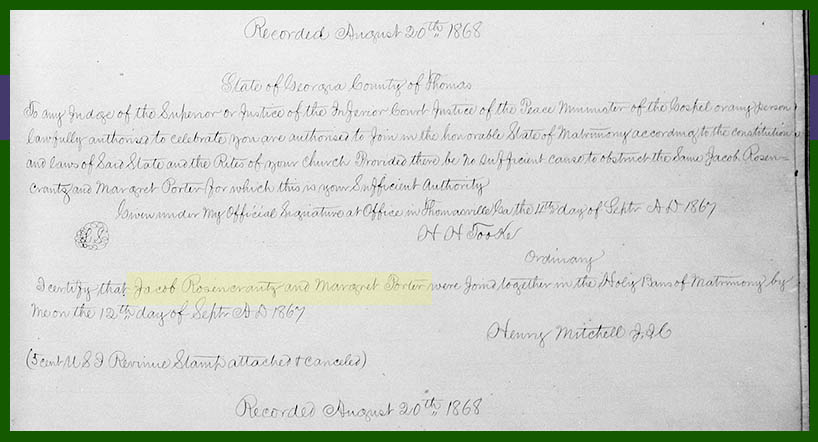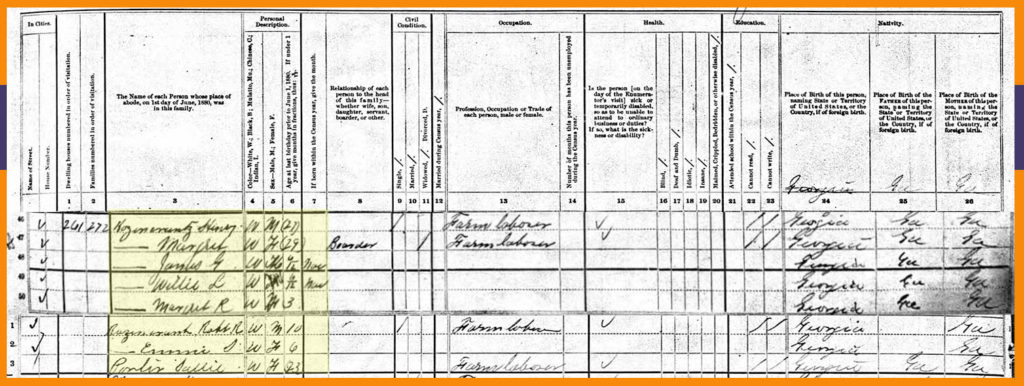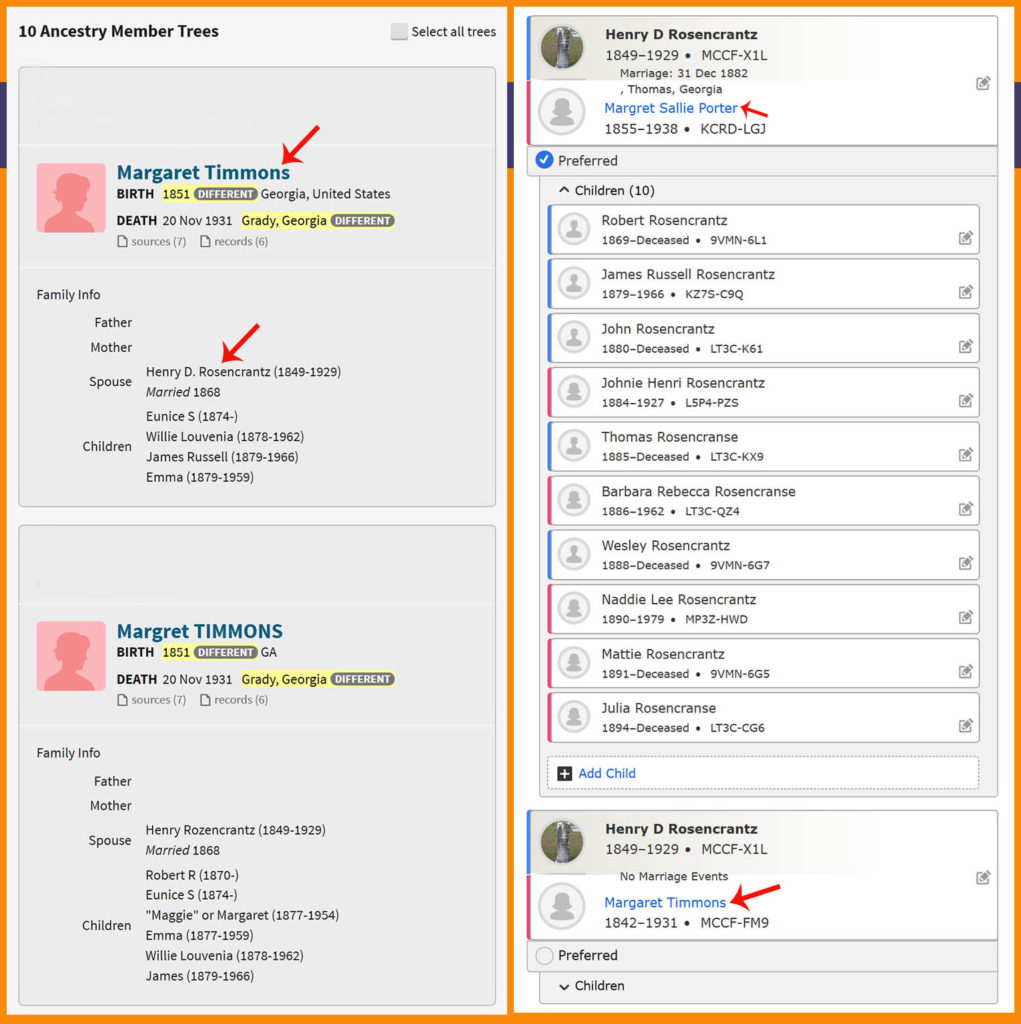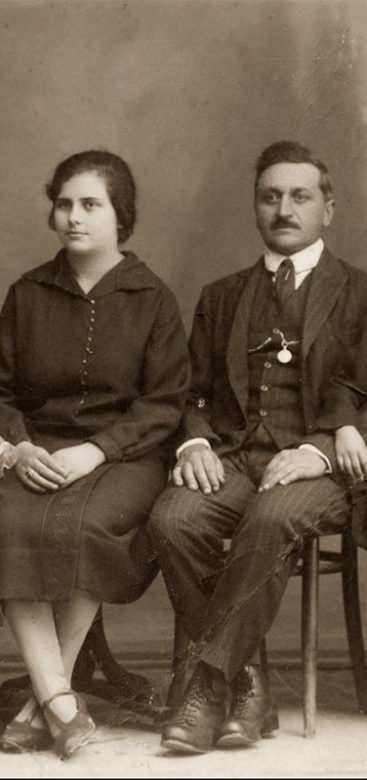
This story is a regular Whodunit.
Except it’s not about death. Or murder.
No. Actually, the opposite end of life — birth. Conception to be more exact.
So perhaps it’s a regular “Whodadaddy.”
Let’s start back in . . . well, it’s actually difficult to know where to start this story. ’Cause it’s a mess — partly because of online family trees. And the fact that it happened back in 1879 just complicates things.
Let’s start with some sex ed
Before we jump into details, we should agree on some groundwork – and, trust me, these details are vital to the story we’re trying to untangle:
- First: The normal human gestation period (we’re talking pregnancy, here) is 40 weeks. Roughly 9 months. But conception usually happens around week 2 of “pregnancy.” (Yes, a woman is “pregnant” for 2 weeks before she’s actually pregnant. It’s kinda weird, but it’s true. You can read all abut it here, if you’d like.)
- Second: In the 1800s, a biological father needed to be physically present at the time of conception. Well, at least a day or two before conception. Said father, however, need not be physically present when a child was born, right. His, um, contribution, is needed only at the very beginning. So, a biological father needed to be alive about 9 months before a child was born.
Ok, we good here? Great. Let’s move on – to 1870.
A strange family in the 1870 census
Here’s a family in the 1870 US Census. (The US government counts its population every 10 years and publishes the results. And now we use those results to stalk our ancestors.)
Every row is about a different person, every column is a question each person was asked.

So what do we see here?
Looks like a young couple – Henry and Margaret Rozencranz (both 21 years old) – and their 1-year-old son Robert living with probably Henry’s 61-year-old father Jacob.
Or maybe Henry and Margaret are siblings, both children of Jacob. That’s what Ancestry.com thought – the website inferred that Jacob is the father of Margaret. And that seems reasonable.
Except . . .
Well, there’s a small clue that most people viewing this census overlooked.
Move right, to column 10 “Place of Birth.” Here we learn where people in this family were born:
- Jacob — Switzerland
- Margaret — Georgia
- Henry — Georgia
- Robert — Georgia
So everyone except Jacob was born in the US.
Now, move right again to columns 11 and 12. Column 11 asks if the person’s father was foreign born. Column 12 if their mom was foreign born. A mark in either box indicates “yes.”So:

- Both of Jacob’s parents were foreign born
- Margaret’s parents are US born
- Henry’s parents are foreign born
- Robert (the 1 year old) — his father is foreign born, but his mother was born in the US.
Hmm… Henry was born in Georgia, in the US. So if Robert’s father is foreign born, then Henry can’t be the father.
What’s going on here?
Well, there’s another possibility: Jacob is married to Margaret, and Robert is their son. And Henry, well in this scenario, he’s probably Jacob’s child from another marriage.
The smoking marriage record
As it turns out, this scenario is correct. Here’s a marriage record from September 1867:

In it we learn that Jacob and Margaret married in September 1867. If you’re keeping track, that puts Margaret about age 18 and Jacob about age 58 when they married. (I try really hard not to insert my own emotions during these situations…)
Margaret was Jacob’s third wife, and Henry was Jacob’s son from the second marriage.
So here’s the timeline that’s shaping up:
- 1867 September — Jacob Rosencrantz marries Margaret Porter
- 1869 Summer — Robert is born to Margaret and Jacob (well, we’ll assume Jacob was the father)
- 1870 June — Jacob, Margaret, and Robert are living with Jacob’s 21-year-old son Henry – who happens to be the same age as his step-mom . . .
Suspicions from the 1880 census
Now, we’re going to jump forward to 1880. Here’s the same family in the 1880 census:

We’ve got Margaret living as a boarder in Henry Rosencrantz’s home. Living with them are two 6-month-old babies (James and Willie), a 3-year-old (Margaret R), a 6-year-old (Emma), 10-year-old Robert, and a 23-year-old woman named Sallie Porter.
We’ll assume Margaret is the mother of all 5 children. Also, Sallie is Margaret’s sister, and she eventually marries Henry.
Where’s Jacob?
Take a look to the right of the word “Boarder” on Margaret’s line. The next 3 small boxes ask whether the person is single, married, or widowed. The “widowed” box is marked for Margaret — Jacob is dead.
So . . . is Jacob the twins’ father?
The skeptic in me now wonders, “Who is the father of twins James and Willie?” Part of the answer to that question lies in knowing when Jacob died.
But before we get into that, let’s look at something in the 1880 census.
Look to the right — all the way over to the last 3 columns. Column 24 asks, “Where you were born?” Followed by “Where was your father born?” And then, of course, “Where was your mother born?”

Notice what the father column says for the 5 children in this home. For the twins and 3-year-old Margaret, it says their father was born in “Ga” — so Georgia. But that column is blank on the older two children (Robert and Emma). Hmm . . . we know from the 1870 census that Jacob (Margaret’s lawful husband) was born in Switzerland. The fact that he was foreign born is what helped us realized that Margaret and Jacob were the couple in the 1870 census.
Could these birth locations be a clue to the paternity of the twins (and young Margaret)?
Maybe. Possibly.
Can you trust the US census?
But . . . look at Henry’s entry. The place of birth for both his parents is Georgia, which we know isn’t correct.
Census info is 100% dependent on WHO gave the info. Could have been a neighbor. Could have been a child. Now I can hear you asking whether we should trust the census info at all? Yes, as a snapshot in time, 100% yes.
Here’s a research principle: The closer in time that a record is made to an actual event, the more likely the info is accurate.
For example, look at the ages of the twins in the 1880 census — “6/12.” That means they’re 6 months old. “4/12” would mean 4 months. “10/12” would be 10 months. And it gets even more specific. The next column records the month they were born “Nov” — meaning November 1879 (since the census was taken in June 1880).

Compare that to Henry and Margaret’s ages. In the 1880 census they’re 27 and 29, respectively. But back in 1870 they’re both listed as 21. I’m not the world’s greatest math lady, but I know that 21+10 doesn’t equal 27 or 29.
How old were these two people?
Take ages in the census a rough estimate within several years of the actual event. You’ll notice that older people have much more fluid ages in censuses. Lies? Maybe. People guessing at ages? Could be true as well.
Just keep in mind that the closer to an event a record was made, the more likely it is to the be the accurate info.
OK, off that soap box, let’s return to the twins’ paternity.
The twins’ actual paternity
I don’t think we can base the twins’ paternity on the father’s “place of birth” answer from the 1880 census.
So how do we find out?
Let’s do some backward math.
- If the twins were born in November 1879, then they would have been conceived about 9 months before. That’s roughly February or March 1879.
- Thus, based on our agreements earlier in this article, Jacob would have had to be alive in February/March 1879 to be the twins’ biological father. If he died before February 1879, then he wasn’t the father.
What we need is a death record for Jacob. One that gives us his exact date of death.
Unfortunately, the state of Georgia didn’t start making death certificates until 1919 — 40 years too late for our needs.
Luckily, though, we can look at the 1880 census’s Mortality Schedules. That’s a morbid-yet-boring name for census page that lists everyone who died between June 1, 1879, and May 31, 1880.
I scoured Georgia Mortality Schedules, and I could NOT find any man with a name like Jacob Rosencrantz and/or fitting his age, birth location, or other defining characteristics.
That suggests Jacob died before June 1, 1879.
Which means that in order for him to be the twins’ bio father, he had to die between Feb and May 1879.
Where is Jacob?
Sadly, I haven’t figured out when Jacob died. I’ve looked through online listings for cemeteries in the areas where he lived. I’ve looked at other family trees. And I’ve looked elsewhere. No luck.
Probably time for some off-line research. Ugh. Why can’t everything I want be accessible from the little box on my desk!?!?! Still,
- There are more cemetery listings at the Family History Library in Salt Lake that I could look through.
- I could try contacting the cities or counties where Jacob lived and see if, by chance, they have any death records for the time period he died.
- I could research what churches were around during the time and place he lived. Perhaps they have burial records I could look through.
- I could also start digging through probate records (wills and such) and land records to see if there is any info there that points to a date of death.
Online family trees complicate things
Why did I tell you this story?
Well, as you’ve now read, this family’s relationships were tangled. Messy. Suspicious.
And the thing is, quite a few people have gotten it wrong in their online family trees. Just check out these examples from Ancestry and FamilySearch:

The image on the left is a listing of Margaret appearing in other people’s family trees. There are 10 Ancestry family trees with Margaret in them. But they all give her maiden name as “Timmons.” We know from her marriage record (and other docs), that she was born “Margaret Porter.”
I don’t know where “Timmons” comes from. But ALL 10 trees on Ancestry give her maiden names as “Timmons.”
All 10 trees also have her married to Henry Rosencrantz — who, as you know, is actually her step-son. Seems these tree builders looked at the 1870 and 1880 censuses, assumed that Henry and Margaret must be married, and moved forward.
So that’s Lesson #1: Go slow with the docs you’re looking at. Take a moment to understand the questions asked when the doc was created or why certain info was included. Then examine the entire doc to find all the clues it holds.
The image above on the right is from FamilySearch’s tree for Henry Rosencrantz. Notice the name of his wife: “Margaret Sallie Porter.”
How do they know that?
Well, they got the maiden name “Porter” right. But they’ve literally combined Margaret and Sallie into one person. (They aren’t.) Then the tree builder listed some of Margaret’s children and all of Sallie’s children as the children of Henry and “Margaret Sallie.”
OK, now hop down to where you see Henry D Rosencrantz’s name listed again. Check out his wife’s name:
“Margaret Timmons.’
Again.
Where does this name come from? I haven’t run across it in any historic docs. I’ve found it only in other people’s family trees — with no source, BTW.
That’s Lesson #2: If an online family tree claims something, ask yourself “How do they know?” Then see if they have historic docs or anything to prove what they’re claiming. We’re not interested in “fake news” here.
Don’t rely on others’ assumptions
You may be thinking, “If at least 11 online family trees say her name is ‘Margaret Timmons,’ isn’t that, maybe, her name? If 11 people are saying this, then maybe they’re right and you, Anastasia, are wrong.”
I guess that’s possible. But think back to Margaret’s marriage doc that we examined in this article. It clearly stated Margaret’s maiden name was “Porter.” So the docs we’ve found show her last name is not “Timmons.”
It’s very possible that one tree builder mistakenly said Margaret’s maiden name was “Timmons,” and then 10 others copied that info in to their tree. “If I found the info online, it must be true . . . right?!?!”
So here in lies Lesson #3 — Don’t rely on other people’s research. Don’t assume it’s correct. I call online family trees an idea. Might be a great, 100% correct idea. Might be totally fiction. (I once found a tree that listed a woman named Eileen as wife of “God the Father” and mother of Jesus.)
I usually don’t look at other people’s trees until I’ve done some research myself. Then I use online family trees as ideas to keep in the back of my mind while I’m researching.
Parting shots
This was my friend Amy’s family tree. She’s related to Margaret and wanted to know who Margaret’s parents were. But as she started looking at the info in trees on FamilySearch and Ancestry, she thought something really strange was going on.
Good for her. ‘Cause this was a strange tangle.
In the case of Margaret, Jacob, and Henry, most people seemed to look at only the names and ages in the 1870 and 1880 censuses and decide that Henry must be Margaret’s husband and her children’s father.
Well . . . it’s possible Henry did father some of her children. But as far as docs go, he was legally never more than her step-son.
What messes have you found in your tree? Please let me know in the comments. I love a good, tangled family tree!
Read Next
Sources
- Ancestry.com. Georgia, Marriage Records From Select Counties, 1828-1978 [database on-line]. Provo, UT, USA: Ancestry.com Operations, Inc., 2013. Original data: County Marriage Records, 1828–1978. The Georgia Archives, Morrow, Georgia.
- Ancestry.com. 1870 United States Federal Census [database on-line]. Provo, UT, USA: Ancestry.com Operations, Inc., 2009. Images reproduced by FamilySearch. Original data: 1870 U.S. census, population schedules. NARA microfilm publication M593, 1,761 rolls. Washington, D.C.: National Archives and Records Administration.
- Ancestry.com and The Church of Jesus Christ of Latter-day Saints. 1880 United States Federal Census [database on-line]. Lehi, UT, USA: Ancestry.com Operations Inc, 2010. 1880 U.S. Census Index provided by The Church of Jesus Christ of Latter-day Saints © Copyright 1999 Intellectual Reserve, Inc. All rights reserved. All use is subject to the limited use license and other terms and conditions applicable to this site. Original data: Tenth Census of the United States, 1880. (NARA microfilm publication T9, 1,454 rolls). Records of the Bureau of the Census, Record Group 29. National Archives, Washington, D.C.
- Ancestry.com. U.S. Federal Census Mortality Schedules, 1850-1885 [database on-line]. Provo, UT, USA: Ancestry.com Operations, Inc., 2010.





Excellent article Anastasia. I good reminder of why we use online family trees solely as survey research in stead of accepting them. Original research the old fashioned way (at least at this point in time) still has a valuable place today in family history research!
Well, thank you. So many trees I come across have major issues, and untangling fact from fiction can be quite the challenge!